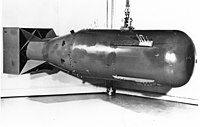
Photo from wikipedia
ABSTRACT This paper presents values as well as the bases for calculating internal dose coefficients suitable for estimating organ doses from the exposure to radioactive fallout that could result from… Click to show full abstract
ABSTRACT This paper presents values as well as the bases for calculating internal dose coefficients suitable for estimating organ doses from the exposure to radioactive fallout that could result from the detonation of a nuclear fission device. The 34 radionuclides discussed are the same as those given in a priority list of radionuclides for fallout dose assessments presented in a companion overview paper. The radionuclides discussed are those that are believed to account for a preponderance of the organ doses that might be received by intake by persons of all ages (including in utero and via breast feeding for infants) following exposure to radioactive fallout. The presented dose coefficients for ingestion account for age and include modifications for variations in solubility with distance as discussed previously in the literature, and those for inhalation similarly account for age, solubility, and particle sizes that would be relevant at various distances of exposure as discussed in a companion paper on ingestion dose methods. The proposed modifications peculiar to radioactive fallout account for systematic changes in solubility and particle sizes with distance from the site of detonation, termed here as the region of "local fallout" and the region "beyond local fallout." Brief definitions of these regions are provided here with more detailed discussion in a companion paper on estimating deposition of fallout radionuclides. This paper provides the dose coefficients for ingestion and inhalation (for particle sizes of 1 μm, 5 μm, 10 μm, and 20 μm) for the region "local fallout." These dose coefficients for "local fallout" are specific for particles formed in a nuclear explosion that can be large and have radionuclides, particularly the more refractory ones, distributed throughout the volume where the radionuclide has reduced solubility. The dose coefficients for the region "beyond local fallout" are assumed to be the ones published by the International Commission on Radiological Protection (ICRP) in 1995. Comparisons of the presented dose coefficients are made with values published by the ICRP.
Journal Title: Health physics
Year Published: 2022
Link to full text (if available)
Share on Social Media: Sign Up to like & get
recommendations!